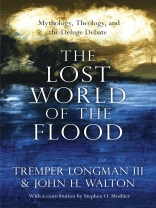‘The flood continued forty days on the earth; and the waters increased, and bore up the ark, and it rose high above the earth . . . and the ark floated on the face of the waters’ (Gen 6:17-18 NRSV).
In modern times the Genesis flood account has been probed and analyzed for answers to scientific, apologetic, and historical questions. It is a text that has called forth ‘flood geology, ‘ fueled searches for remnants of the ark on Mount Ararat, and inspired a full-size replica of Noah's ark in a theme park. Some claim that the very veracity of Scripture hinges on a particular reading of the flood narrative. But do we understand what we are reading?
Longman and Walton urge us to ask what the biblical author might have been saying to his ancient audience. Our quest to rediscover the biblical flood requires that we set aside our own cultural and interpretive assumptions and visit the distant world of the ancient Near East. Responsible interpretation calls for the patient examination of the text within its ancient context of language, literature, and thought. And as we return from that lost world to our own, we will need to ask whether geological science supports the notion of flood geology.
To read Longman and Walton is to put our feet on firmer interpretive ground. Without attempting to answer all of our questions, they lift the fog of modernity and allow the sunlight to reveal the true contours of the text. As with other books in the Lost World series, The Lost World of the Flood is an informative and enlightening journey toward a more responsible reading of a timeless biblical narrative.
The books in the Lost World Series follow the pattern set by Bible scholar John H. Walton, bringing a fresh, close reading of the Hebrew text and knowledge of ancient Near Eastern literature to an accessible discussion of the biblical topic at hand using a series of logic-based propositions.
Jadual kandungan
Abbreviations
Preface
Part I: Method: Perspectives on Interpretation
Proposition 1: Genesis Is an Ancient Document
Proposition 2: Genesis 1–11 Makes Claims About Real Events
Proposition 3: Genesis Uses Rhetorical Devices
Proposition 4: The Bible Uses Hyperbole to Describe Historical Events
Proposition 5: Genesis Appropriately Presents a Hyperbolic Account of the Flood
Proposition 6: Genesis Depicts the Flood as a Global Event
Part II: Background: Ancient Near Eastern Texts
Proposition 7: Ancient Mesopotamia Also Has Stories of a Worldwide Flood
Proposition 8: The Biblical Flood Story Shares Similarities and Differences with Ancient Near Eastern Flood Accounts
Part III: Text: Understanding the Biblical Text Literarily and Theologically
Proposition 9: A Local Cataclysmic Flood Is Intentionally Described as a Global Flood for Rhetorical Purposes
Proposition 10: The Flood Account Is Part of a Sequence of Sin and Judgment Serving as Backstory for the Covenant
Proposition 11: The Theological History Is Focused on the Issue of Divine Presence, the Establishment of Order, and How Order Is Undermined
Proposition 12: The ‘Sons of God’ Episode Is Not Only a Prelude to the Flood; It Is the Narrative Sequel to Cain and Abel
Proposition 13: The Tower of Babel (Genesis 11:1-9) Is an Appropriate Conclusion to the Primeval Narrative
Part IV: The World: Thinking About Evidence for the Flood
Proposition 14: The Flood Story Has a Real Event Behind It
Proposition 15: Geology Does Not Support a Worldwide Flood (Steve Moshier)
Proposition 16: Flood Stories from Around the World Do Not Prove a Worldwide Flood
Proposition 17: ‘Science Can Purify Our Religion; Religion Can Purify Science from Idolatry and False Absolutes’
Conclusion
Notes
For Further Reading
Author Index
Subject Index
Scripture Index
Mengenai Pengarang
Stephen O. Moshier (Ph D, Louisiana State University) is professor of geology at Wheaton College and director of the Black Hills Science Station. Among his areas of interest is the field of geoarcheology.







![perlindungan daripada Brian Schrag & Julisa Rowe: Community Arts for God's Purposes [Chinese] 貼近神心意的社群藝術 perlindungan daripada Brian Schrag & Julisa Rowe: Community Arts for God's Purposes [Chinese] 貼近神心意的社群藝術](https://static.worldofdigitals.com/thumb_webp/740/9781645083740.webp)




